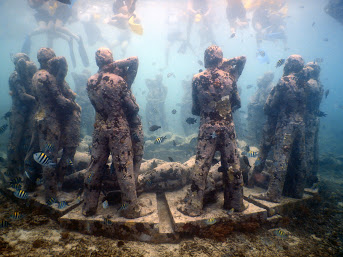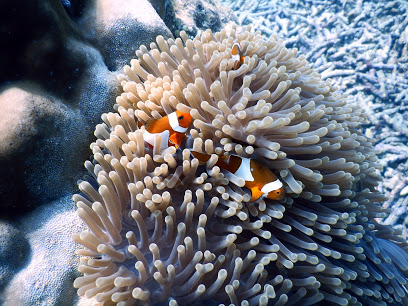We decided to head to Gili Air after Komodo. Gili Air is one of the three Gili islands just off the coast of Lombok and we chose Gili Air as it’s famous for it laid back living. We needed a bit of R & R after island hopping around Indonesia and heard great things about its dive sites.

Diving at Gili Air was in the warmest water EVER!
It was very odd as it seriously felt like a warm bath. There are a lot of dive sites in Gili Air and what makes it even better is each dive site is 30 min or less to get there. We stayed in a hotel right next to a dive shop and we met and hung out with a lot of people doing there PADI here. In hindsight, if we had the chance to do our PADI again we would have chosen Gili as the destination, mainly due to the short boat rides so we could do most the dives in the morning and have the afternoon free. In most countries where you can dive a lot of the time is spent getting to the dive sites (something we didn’t realise) whereas here it was just around the corner.
Here are our top three recommendations for Gili.
Diving is like an aquarium in Gili Air
The water in Gili Air is super clear and ridiculously warm. It’s famous for ‘Turtle Point’ diving site as the northern part of the island is home to sea turtles. You’re guaranteed to sea a turtle and during our diving we saw SO many it felt like an aquarium being up close to such giant turtles.

The Gili islands are home to two species of turtle the Green turtle and the Hawkbill. The most common is the Green Turtle with its patterned shell and green colouring on its cartilage and fat whereas the Hawksbill turtle is recognisable by its distinctively shaped face with a sharp narrow head and bird like beak. The Hawksbill turtle is listed as critically endangered around the world due to its low population.
The only sad thing about this was the exploitation of the site and of tourists by the snorkelling tour operators. All of the tours gave guarantees about seeing turtles, something which should never be done in the wild as nothing is a guarantee. As a result, almost all snorkelling tours dumped their groups above turtle point given this is the most likely place to see turtles. That meant there were hundreds (not an exaggeration) of people trying to snorkel in this tiny little patch of water. Due to how packed in they were most could barely get their head in the water to look down, and even then, the turtles were a good 12-15m below the surface. It was slightly surreal for us diving as we were blissfully unaware of what was above us as we were diving around the turtles at the bottom of the ocean, but as we started to ascend we saw a massive blob of about a hundred or more legs desperately struggling to see a turtle. It was sad to see nature (and to a lesser extent tourists) being exploited in this way.
Temple Dive
Another interesting dive we did was the underwater statues. The dive site was home to 48 human like statues meant to represent a bridge between the human world and the marine world. The dive site was created to promote coral growth and soon enough the statues will be covered. It’s a 5m dive and whilst I did enjoy the dive the experience wasn’t the best with dozens and dozens of snorkelers trying to free dive down. As you can see from the picture it was very crowded.
Diving in Gili was like an underwater aquarium as we found Nemo, reef sharks, frog fish and many more. It’s one of the best place to dive especially for newcomers.
Swings and sunrises
We loved the R & R atmosphere in Gili Air. Near most restaurants and beaches you could spot a swing. The island is so beautiful and tranquil and we needed a bit of time to reset before the start of 2020. We woke up early one day to see the sunrise and just relax on the swing and it was absolutely stunning.
Gili Air is about laid back living and was the perfect way for us to welcome 2020.
Happy (very) belated New Year everyone.











